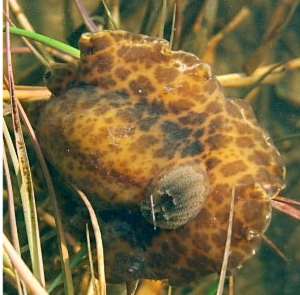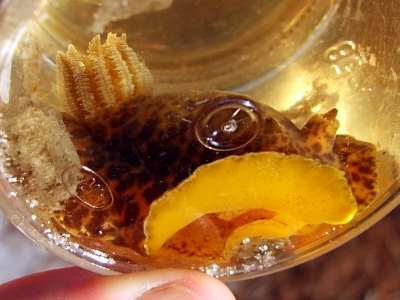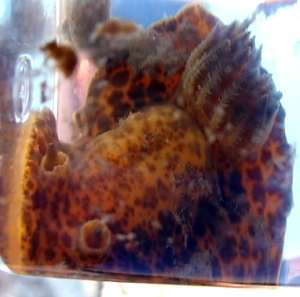
Diaulula greeleyi
(MacFarland, 1909)
Order: NUDIBRANCHIA
Suborder: DORIDINA
Superfamily: EUDORIDOIDEA
Family: Dorididae
DISTRIBUTION
Western Atlantic from Brazil to Sth Carolina. East Pacific [Mexico, Costa Rica].
PHOTO
St. Joseph Bay, Florida, Florida, USA. Atlantic. Depth: less than 1 foot at low tide. Length: 3 inches. 9 April 2005. sandy bottomed sea grass meadow. Photographer: Mike Greenemeier
Large flat dorid with mantle covered in caryophyllidia, giving the back a furry appearance. Mantle yellow to yellowish brown with darker brown patching scattered all over, and some whitish patches around the mantle edge. Both the rhinophore and gill openings are surrounded by a high sheath. The gills are large but simple and unbranched. Underside bright yellow.
Camacho-Garcia & Valdés (2003) transfer this species from Peltodoris to Diaulula and consider the East Pacific Peltodoris nayarita Ortea & Llera, 1981 to be a synonym, extending its distribution from the western Atlantic to the eastern Pacific.
-
Camacho-Garcia, Y. & Valdés, A. (2003) Caryophyllidia-bearing dorid nudibranchs (Mollusca Nudibranchia Doridina) from Costa Rica. Proceedings of the California Academy of Sciences, 54(4): 65-79.
-
Eyster, L. S. (1980) Distribution and reproduction of shell-less opisthobranchs from South Carolina. Bulletin of Marine Science, 30(3): 580-599.
-
MacFarland, F. M. (1909) The opisthobranchiate Mollusca of the Branner-Agassiz expedition to Brazil. Leland Stanford Junior University Publications, University Series (2):1-104, pls. 1-19.
-
Marcus, Er. (1955) Opisthobranchia from Brazil. Boletim da Faculdade de Filosofia, Ciencias e Letras, Universidade de Sao Paulo, Zoology, 207, 20:89-261, pls. 1-30.
-
Marcus, Ev., & Marcus, Er. (1967) American opisthobranch mollusks. Part I, Tropical American opisthobranchs. Part II, Opisthobranchs from the Gulf of California. Studies in Tropical Oceanography, Miami, 6(1-2):1-256.
-
Valdes, A. (2004) Tropical western Atlantic species of Diaulula Bergh, 1878 (Mollusca, Nudibranchia), with the description of a new species. Contributions in Science, 501: 1-7
-
Zeiller, W. (1974) Tropical Marine Invertebrates of Southern Florida and the Bahama Islands. John Wiley & Sons: New York. 132 pp.
Rudman, W.B., 2005 (May 2) Diaulula greeleyi (MacFarland, 1909). [In] Sea Slug Forum. Australian Museum, Sydney. Available from http://www.seaslugforum.net/find/diaugree
Related messages
Re: Dorid from northwest Florida
May 3, 2005
From: Alma Sanchez-Santos
Dear Dr. Rudman and Mike Greenemeier
Concerning Mike Greenemeier's message #13508:
I think this animal is very similar to Diaulula greeleyi (MacFarland, 1909). Marcus and Marcus (1967) recorded this species in the coast of Florida.
For more information see:
- Camacho-García, Y. and Valdés, A. 2003. Caryophyllidia-bearing dorid nudibranchs (Mollusca, Nudibranchia, Doridacea) from Costa Rica. Proceedings of the California Academy of Sciences, 54: 65-79.
Best wishes,
Alma
almasanchez83@hotmail.com
Sanchez-Santos, A., 2005 (May 3) Re: Dorid from northwest Florida. [Message in] Sea Slug Forum. Australian Museum, Sydney. Available from http://www.seaslugforum.net/find/13570Dear Alma,
Thanks for drawing my attention to this paper. I had looked at Marcus's descriptions of Peltodoris greeleyi and hadn't been able to convince myself that it was the same thing. I guess I was looking for a clear description of the high rhinophore sheaths which to me seem a very chracteristic feature of the species.
Concerning the rhinophore sheaths, I am puzzled by some comments in Camacho-Garcia & Valdés (2003) where they transfer this species to Diaulula and consider the East Pacific Peltodoris nayarita Ortea & Llera, 1981 to be a synonym. They state 'the species [P. greeleyi] is transferred to the genus Diaulula due to a combination of features: ...... the low rhinophoral and branchial sheaths, ......' and yet later they say 'D. greeleyi is also different from D. aurila in radular morphology ..... the presence of high rhinophoral and branchial sheaths ......'. It is not clear from that whether D. greeleyi has high or low rhinophoral sheaths, and if high sheaths are considered a character of Diaulula, how is it that one species can have high sheaths and the other low?
Best wishes,
Bill Rudman
Re: Dorid from northwest Florida
May 3, 2005
From: Colin Redfern
Dear Bill,
Concerning Mike Greenemeier's message #13508:
I believe this is Diaulula greeleyi (MacFarland, 1909). I have attached photos and text are from Zeiller (1974), as Peltodoris greeleyi, who incorrectly named Marcus & Marcus as authors. The left-hand photo is correctly identified, but the two animals in the right-hand photo, referred to here as a color form, are in fact examples of Diaulula farmersi Valdes, 2004.
-
Marcus, Er. (1955) Opisthobranchia from Brazil. Boletins da Faculdade de Filosofia, Ciencias e Letras da Universidade de Sao Paulo, Zoologia 20: 89-262.
-
Marcus,Ev. & Er. Marcus. (1967) American Opisthobranch Mollusks. Studies in Tropical Oceanography 6. 256 pp.
-
Valdes, A. (2004) Tropical western Atlantic species of Diaulula Bergh, 1878 (Mollusca, Nudibranchia), with the description of a new species. Contributions in Science, 501: 1-7.
-
Zeiller, W. (1974) Tropical Marine Invertebrates of Southern Florida and the Bahama Islands. John Wiley & Sons: New York. 132 pp.
Best wishes,
Colin
bahamianseashells@att.net
Redfern, C., 2005 (May 3) Re: Dorid from northwest Florida. [Message in] Sea Slug Forum. Australian Museum, Sydney. Available from http://www.seaslugforum.net/find/13576Dear Colin,
Thanks for the scan of Zeiller's page. Unfortunately for copyright reasons I can't copy it withour permission, but certainly the left hand animal is the same. I had looked at Marcus' descriptions of this species and hadn't been able to clearly identify it as this species but I am happy to accept the views of local workers. I must say the high rhinophore sheaths are very distinctive.
Best wishes,
Bill Rudman
Dorid from northwest Florida
April 19, 2005
From: Mike Greenemeier

I found this nudibranch in a shallow turtle grass meadow in St. Joseph Bay, Florida (NW Florida). When I originally found it, it was on a sponge that was nearly the same color. Unfortunately I didn't have a camera with me and my collecting jar was too small to get the sponge too. I was hoping you could identify it for me.
Locality: St. Joseph Bay, northwest Florida, in the Gulf of Mexico, USA. Atlantic. Depth: less than 1 foot at low tide. Length: 3 inches. 9 April 2005. sandy bottomed sea grass meadow. Photographer: Mike Greenemeier (The picture of it on the vegetation is not where I found it. It was just an attempt to get a picture of it not in a jar.)
Thanks,
Mike Greenemeier
greenm3@auburn.edu


Dear Mike,
I feel I should know this rather conspicuous dorid but I admit defeat. But i hope someone familiar with the fauna can help.
Best wishes,
Bill Rudman
